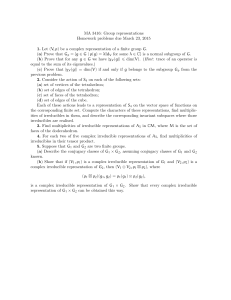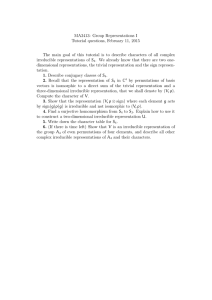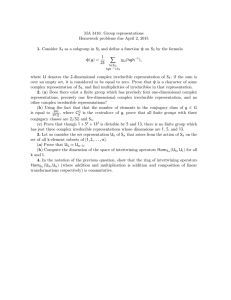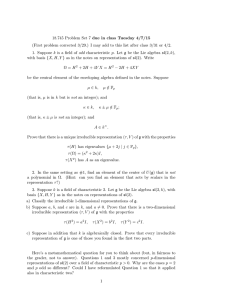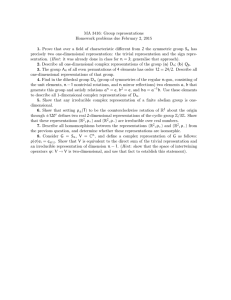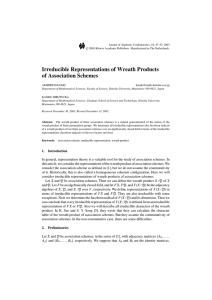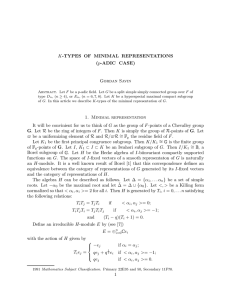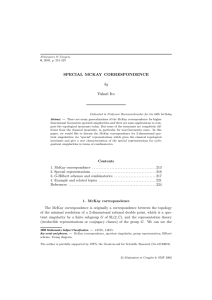1. 18.757 Homework 8 solutions binary icosahedral group I
advertisement
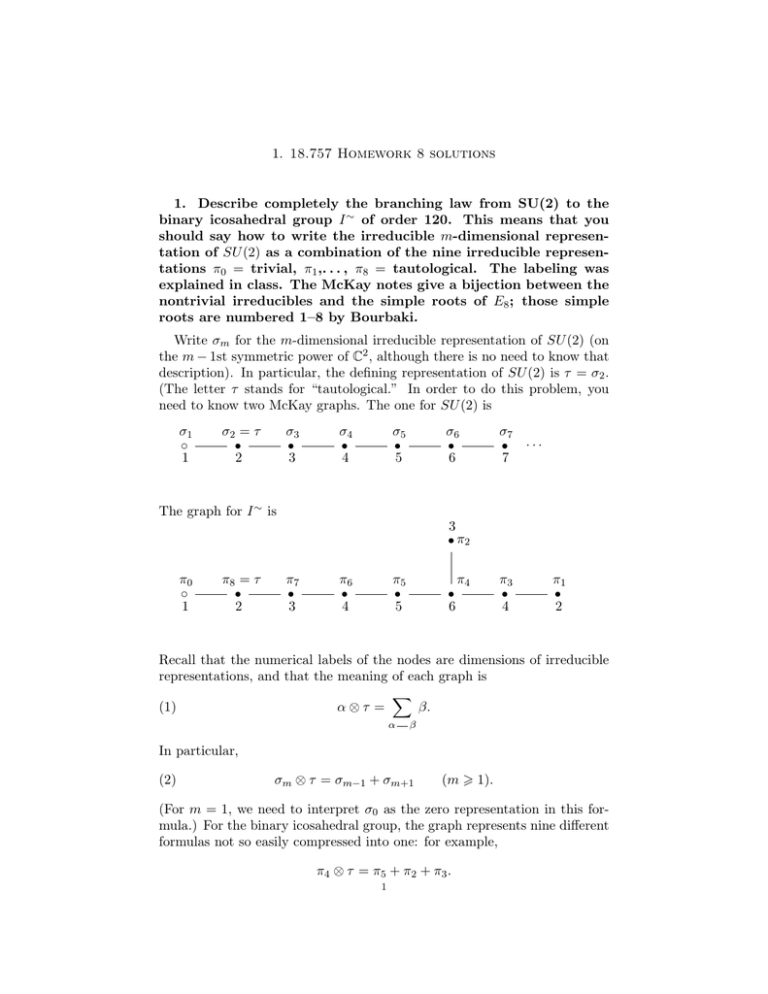
1. 18.757 Homework 8 solutions 1. Describe completely the branching law from SU(2) to the binary icosahedral group I ∼ of order 120. This means that you should say how to write the irreducible m-dimensional representation of SU (2) as a combination of the nine irreducible representations π0 = trivial, π1 ,. . . , π8 = tautological. The labeling was explained in class. The McKay notes give a bijection between the nontrivial irreducibles and the simple roots of E8 ; those simple roots are numbered 1–8 by Bourbaki. Write σm for the m-dimensional irreducible representation of SU (2) (on the m − 1st symmetric power of C2 , although there is no need to know that description). In particular, the defining representation of SU (2) is τ = σ2 . (The letter τ stands for “tautological.” In order to do this problem, you need to know two McKay graphs. The one for SU (2) is σ1 σ2 = τ σ3 σ4 σ5 σ6 σ7 1 2 3 4 5 6 7 c s s s s s s ··· The graph for I ∼ is 3 sπ2 π0 π8 = τ π7 π6 π5 s s 1 2 3 4 5 6 c s s s π4 π3 π1 4 2 s s Recall that the numerical labels of the nodes are dimensions of irreducible representations, and that the meaning of each graph is X β. (1) α⊗τ = α β In particular, (2) σm ⊗ τ = σm−1 + σm+1 (m > 1). (For m = 1, we need to interpret σ0 as the zero representation in this formula.) For the binary icosahedral group, the graph represents nine different formulas not so easily compressed into one: for example, π4 ⊗ τ = π5 + π2 + π3 . 1 2 Formula (2) is an isomorphism of representations of SU (2). If we restrict it to the binary icosahedral group, we get (3) (σm |I ∼ ) ⊗ τ = (σm−1 |I ∼ ) + (σm+1 |I ∼ ) (m > 1). Equation (3) is an inductive procedure for computing the restriction of σm to I ∼ . The base case m = 1 corresponds to the trivial representation of SU (2), which restricts to the trivial representation of I ∼ : σ1 |I ∼ = π0 . In the inductive step, we assume m > 2, and that we already know the restrictions σm−1 |I ∼ and σm |I ∼ . Then we compute (4) σm+1 |I ∼ = (σm |I ∼ ) ⊗ τ − σm−1 |I ∼ . The first term on the right is computed from the McKay graph for the binary icosahedral group, together with our inductive knowledge of branching for σm ; and the second we simply know by induction. The minus sign is at the level of multiplicities of irreducible representations (or, more formally, in the Grothendieck group of virtual representations of I ∼ ). Here are the first few cases: σ2 |I ∼ = [(σ1 |I ∼ ) ⊗ τ ] − σ0 |I ∼ = [π0 ⊗ τ ] − 0 = π8 (5) σ3 |I ∼ = [(σ2 |I ∼ ) ⊗ τ ] − σ1 |I ∼ = [π8 ⊗ τ ] − π0 = [π0 + π7 ] − π0 = π7 Below I have tabulated the results of this calculation for m 6 30. (I have written πj (d) when dim πj = d, in order to make it easier to see that the dimensions in row m add to m.) Here are some periodicity properties which allow you to fill in the rest of the table. (1) The multiplicity functions mσm (πj ) extend to all m ∈ Z, by mσ−m (πj ) = −mσm (πj ). The recursion formulas (3), etc., continue to hold. (2) The multiplicities mσm (π0 ), mσm (π7 ), mσm (π5 ), mσm (π2 ), mσm (π3 ) are all zero unless m is odd. (3) The multiplicities mσm (π8 ), mσm (π6 ), mσm (π4 ), mσm (π1 ) are all zero unless m is even. (4) The multiplicity functions are “almost periodic” of period 60: mσm+60 (πj ) = mσm (πj ) + dim πj . (5) The even multiplicity functions are “almost periodic” of period 30: mσ2m+30 (πj ) = mσ2m (πj ) + (dim πj )/2. 3 σ−2 σ−1 σ0 σ1 σ2 σ3 σ4 σ5 σ6 σ7 σ8 σ9 σ10 σ11 σ12 σ13 σ14 σ15 σ16 σ17 σ18 σ19 σ20 σ21 σ22 σ23 σ24 σ25 σ26 σ27 σ28 σ29 σ30 σ31 π0 (1) π7 (3) π5 (5) π2 (3) π3 (4) π8 (2) π6 (4) π4 (6) π1 (2) 0 0 0 0 0 -1 0 0 0 -1 0 0 0 0 0 0 0 0 0 0 0 0 0 0 0 0 0 1 0 0 0 0 0 0 0 0 0 0 0 0 0 1 0 0 0 0 1 0 0 0 0 0 0 0 0 0 0 0 0 0 1 0 0 0 0 1 0 0 0 0 0 0 0 0 0 0 0 0 0 1 0 0 0 0 1 1 0 0 0 0 0 0 0 0 0 0 0 1 1 0 0 1 0 1 0 0 0 0 0 0 0 0 0 0 1 1 0 0 1 1 1 0 0 0 0 0 0 0 0 0 0 1 1 1 0 1 1 1 0 1 0 0 0 0 0 0 0 0 0 1 1 1 1 0 1 1 1 1 0 0 0 0 0 0 0 0 0 0 1 2 0 0 0 2 1 1 0 0 0 0 0 0 0 0 0 0 1 2 1 0 1 1 1 2 0 0 0 0 0 0 0 0 0 1 1 2 1 1 1 2 1 1 0 0 0 0 0 0 0 0 0 1 2 2 0 0 2 2 1 1 0 0 0 0 0 0 0 0 0 1 2 2 1 1 1 2 1 2 0 0 0 0 0 0 0 0 0 1 1 3 1 0 1 2 2 2 0 0 0 0 0 0 0 0 0 0 2 3 1 0 1 3 1 2 0 0 0 0 0 0 0 0 0 1 2 3 1 1 2 2 2 2 0 0 0 0 Branching law for I ∼
